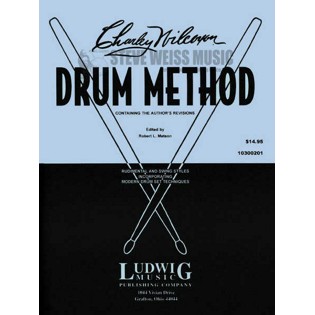The emphasis here is on rudiments and syncopated phrases, in the the 30's swing drumming mode, before before four-way coordination, and before use of the ride cymbal and hi-hat were universal. The approach to rudiments is different than in traditional military-style drumming, as in Haskell Harr
Most of the book deals with quarter and 8th notes in 4/4 and cut time, plus 3/4 and 6/8. Syncopated and even meter-within-meter rhythms and accent patterns are introduced early, in the quarter note section, and exercises generally have a swing lilt. Remarkably, 16th notes in #/4 meters are not fully explored until page 91. Notably absent are the mathematical/logical sequences of exercises that became a primary feature of many drum books after George L. Stone's Stick Control
It's somewhat easy to miss the fact that this is a drum set method book. The bass drum is used simply throughout, playing either quarter notes or half notes, and occasionally filling in breaks or supporting an accent pattern in the hands. Aside from a few dedicated hihat exercises, most of the book uses only the bass drum and hands. Jazz ride cymbal and hi-hat patterns are presented as stand-alone time feels, with no comping in the modern Kenny Clarke/Max Roach/Chapin
I've found it to be very useful in my own practice- I'm very fond of the pages of two bar breaks, "rhumba studies", 3/8 studies, 16th notes, and triplet/8th note combinations. Along with several of the later etudes, which are less dense and more focused on a single idea than those from Wilcoxon's other books. And it's nice to see earlier versions of the the type of phrases used in more modern books, like Ted Reed's Syncopation
Purchase the Wilcoxon Drum Method.


I've been revisiting Wilcoxon lately. Interesting that so little information is availble on the man.
ReplyDeleteHis All American Solos and Swing Solos are among the most used books.
Oddly, the copy I have of "Drum Method" is copywritten in 1981. Do you have any idea when the initial copyright is?